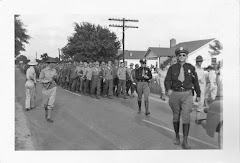
On December 4, 1943, German POW Hermann Blumhardt wrote in the small diary he kept that his friend Walter Felholter was being moved to the Camp Aliceville hospital because he had diphtheria.
Walter remembers that his sore throat had become worse and worse. "I couldn't swallow, and it was swollen," he has said. At first, he was very sick, but his condition gradually improved and he found, as time went on, that he liked the camp hospital. The food prepared by Elma Henders was excellent, no work details were required, and there was plenty of time and solitude for reading and learning English.
In February 1944, Walter and a number of other prisoners who had been diagnosed with diphtheria were moved from the camp hospital to a quarantined area in Compound B. They were moved because influenza had hit the camp, and the hospital beds were needed for new patients. Because these men were still considered contagious for diphtheria, they could not have close contact with other POWs. They ate their meals together in the Compound B. mess hall after all the other POWs were finished.
Every Wednesday and Saturday morning, camp nurses came into the compound to collect throat cultures so they could determine the status of the POWs. If a prisoner tested negative for diphtheria three cultures in a row, he was considered cured and returned to his regular barracks and his regular duties.
Because Walter Felholter and others had heard stories about POW transfers to labor camps, they came up with a plan to continue their quiet and pleasant status in Compound B for as long as they could. Whenever they had their throats swabbed, the four men would switch their glass slides before the nurse came in to label them. This allowed them to make sure that no one who had already received two negative evaluations would receive a third (confirming that he no longer had the disease). In this way, the last "four positives" (pictured above) were able to remain in Compound B until late May.
"We liked to stay in the hospital," Walter has said, "because we didn't have to work then. Otherwise, we had to truck somewhere to pick cotton or something else."
A SIDE NOTE: If you look closely at the photo above, you can see the neat wooden shingles and the base of a window box behind the bench where the men are sitting. There is also some shrubbery to the left of the bench. During their first few months in Camp Aliceville, the German POWs transformed their bare tarpaper-covered barracks into somewhat pleasant surroundings with shingles, awnings, flower boxes, and landscaping. They used their canteen money to purchase the materials needed.






No comments:
Post a Comment